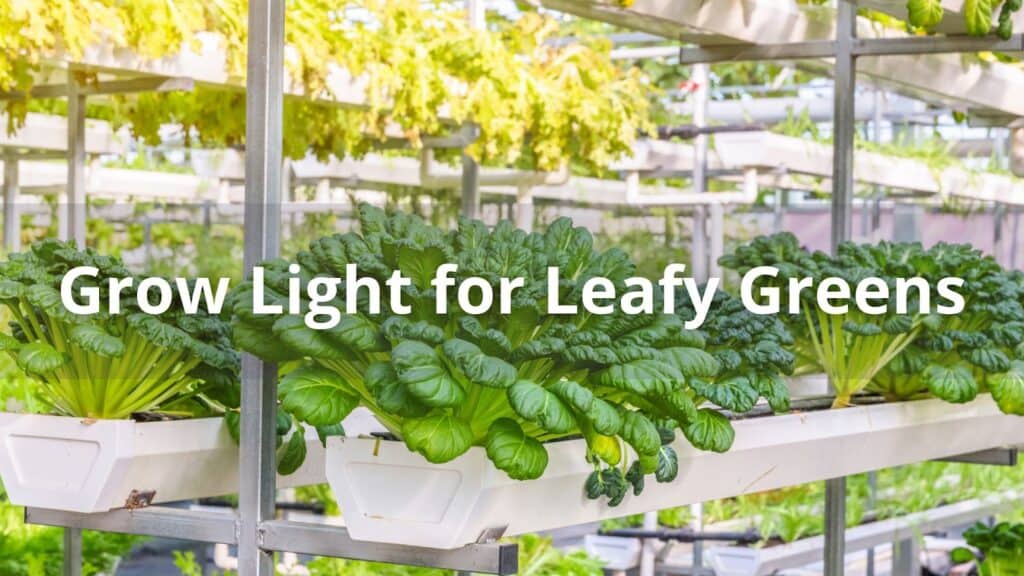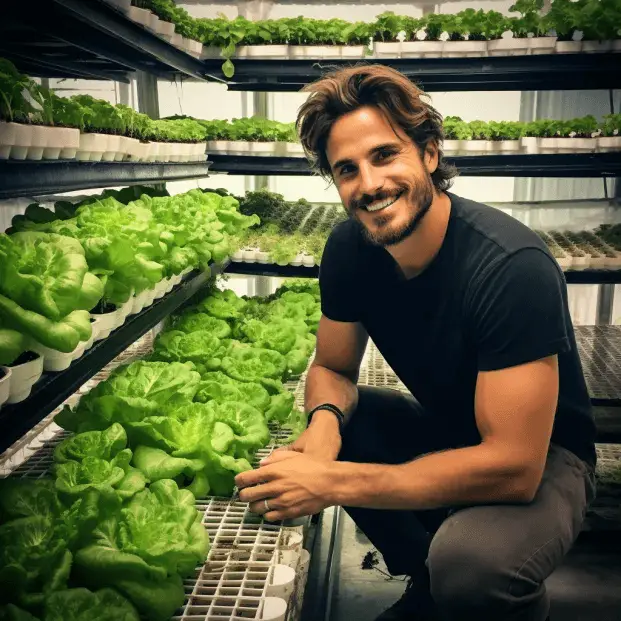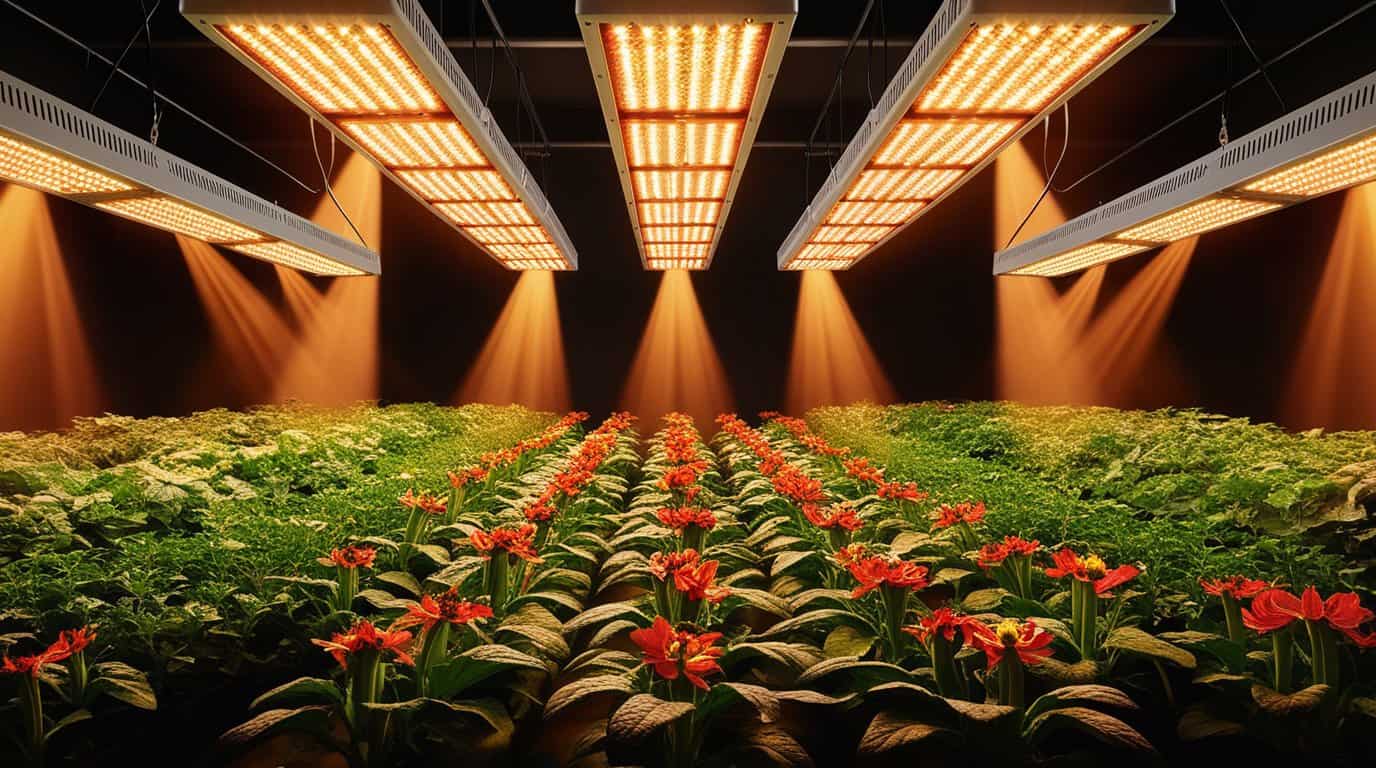Growing leafy green vegetables can be a fun and rewarding experience, especially if you have a garden inside your home. But what if you don’t have much sunlight? That’s where grow lights come in! These lights can help your plants get the light they need to grow healthy and strong (1). Keep reading to find out how to pick the best grow light for your leafy greens!
Key Takeaway
- Grow lights help leafy greens grow inside, even without much sunlight.
- LEDs are the best choice because they save energy and last a long time.
- Right light and care can give you fresh greens all year round.
Types of Grow Lights

When it comes to grow lights, there are different types you can choose from. Some are better for leafy greens than others. Here’s a quick list of some popular options:
- LED Grow Lights: These are super popular! They use less energy and can make the light your plants need. You can change the color of the light, like red for flowering and blue for leafy greens. This means they help your plants grow big and strong.
- Fluorescent Grow Lights: These lights are the ones you might know from school. They come in T5 and T8 sizes. They are not as energy-efficient as LEDs, but they still work well for leafy greens. They give a lot of light and are often used with hydroponic systems (that’s a way of growing plants without dirt).
- HPS (High-Pressure Sodium) Grow Lights: These lights are usually used for flowering plants. They can work for leafy greens, but they’re not as good as LEDs. They produce more heat, and that can be a problem if you’re not careful.
- CFL (Compact Fluorescent Lamp) Grow Lights: These are like the ones you use in your home, but made for plants. They are usually cheaper than LEDs but not as efficient.
So, if you want your leafy greens to grow, LED grow lights are probably the best choice for you!
Key Considerations for Leafy Greens
When you’re growing leafy greens, there are a few things to keep in mind about light.
Spectrum
Leafy greens thrive in blue and green light (2). They grow strong and healthy. Blue light is like a magic wand, making leaves grow. It helps plants make more food. Green light is different. It goes deeper into the plant, reaching parts that blue light can’t touch. This means the plant can use more light to grow.
Plants like spinach, kale, and lettuce respond well to this special light. They might grow bigger and tastier. It’s fascinating how light can change a plant’s life. A good way to help leafy greens flourish is to use grow lights that focus on blue and green light.
For example, a grow light that gives off 400 to 500 nanometers of blue light and about 500 to 550 nanometers of green light could really help. This can make a big difference in the garden. So, if growing greens is the goal, light choices matter a lot!
Intensity
Leafy greens are pretty low-key when it comes to light. They don’t need the super bright lights that flowering plants crave. Instead, they prefer a cozy glow (3). A good guideline is to use 20 to 40 watts of light for every square foot of leafy greens. This makes it easy to plan the perfect setup.
For example, if someone has a garden that’s 4 feet by 4 feet, that’s 16 square feet. So, they would need between 320 to 640 watts of light. That sounds like a lot, but it’s just the right amount for leafy greens.
It’s interesting how these plants thrive on less. They can grow well in lower light, making them great for beginners. Plus, it saves energy and keeps things simple. So, for anyone growing greens, keeping it mellow with the light can lead to a bountiful harvest!
Distance
When using grow lights, distance matters a lot. If the lights are too close, the plants can get burned. It’s like standing too close to a campfire. Ouch! The ideal distance is usually about 6 to 12 inches away from the leafy greens. This keeps them warm and happy without causing any harm.
For example, if the lights hang too low, the leaves might turn crispy and brown. That’s not a good sign. On the flip side, if the lights are too far away, the plants won’t get enough light. They might stretch and look sad, searching for that bright glow.
Finding the sweet spot is key. Checking the plants often helps. If they look healthy and vibrant, the lights are probably in the right spot. So, keeping those grow lights at the right distance can lead to a thriving garden full of leafy greens!
Duration
Leafy greens love their light! They thrive best with about 12 to 14 hours of light each day. That’s a good amount of time for them to soak up the rays and grow strong. It’s like a daily sun bath that helps them stay healthy and vibrant.
For those growing greens indoors, using a timer can be super helpful. It makes sure the lights turn on and off at the same time every day. This way, the plants get their needed light without any fuss.
Keeping these things in mind will help keep leafy greens happy and growing! A balanced light schedule, the right distance for grow lights, and the right wattage can create the perfect environment. With a little care, anyone can grow a garden full of delicious, leafy greens!
Benefits of Using Grow Lights for Leafy Greens

Using grow light for leafy greens brings some fantastic benefits (4). Here are a few reasons to consider them:
- Year-Round Production: Grow lights let anyone grow greens any time of the year. It doesn’t matter if it’s snowing outside or if it’s super hot. Fresh greens can be grown indoors.
- Controlled Environment: With grow lights, creating the perfect spot for plants is easy. Temperature and humidity can be managed, helping the plants thrive like they’re in a cozy greenhouse.
- Increased Yield: Grow lights can help plants grow bigger and produce more leaves. More greens mean more salads! It’s like having a mini salad factory right at home.
- Pest Control: Growing indoors lowers the chance of pests and diseases. That means leafy greens can stay healthy and safe from pesky bugs that love to munch on them.
Using grow lights can really help grow more leafy greens in a safe way! With these benefits, it’s easier than ever to enjoy delicious greens all year long.
Setting Up Grow Lights for Leafy Greens
Credits: Migardener
Now that you know about grow lights, setting them up for leafy greens is pretty simple. Here’s how to do it:
- Choose the Right Light: First, find a grow light that gives off the right color and brightness for leafy greens. LEDs are a great choice! They are energy-efficient and provide the right spectrum of light.
- Position the Lights: Next, make sure to put the lights at the right distance from the plants. The sweet spot is usually 6 to 12 inches away. Too close can burn the leaves, and too far can leave them in the dark.
- Set a Lighting Schedule: Use a timer to keep the lights on for 12 to 14 hours each day. This helps ensure the plants get enough light without any fuss. Timers are super handy!
- Monitor and Adjust: Finally, check on the plants regularly. If they look sad or stretched out, it might be time to change the light settings or move the lights a bit closer or farther away.
Setting up grow lights is not hard at all, and it can really make a difference for leafy greens! With the right setup, anyone can enjoy a healthy harvest.
FAQ
How does the grow light spectrum affect different leafy greens?
The light spectrum needs vary slightly between plants. Lettuce needs different light settings than kale or spinach. Generally, leafy greens thrive under full-spectrum lights with extra blue light for leaf development.
What’s the best setup for growing microgreens and small leafy vegetables?
Microgreens thrive in vertical farming systems. When growing arugula, watercress, or bok choy, position the lights closer to the plants than you would for larger greens. This setup works especially well for indoor containers.
How should I adjust grow lights for seasonal changes?
Lights need to be stronger and run longer in winter than in summer. In spring and fall, adjust the duration gradually. These adjustments apply whether you’re growing in greenhouses or indoor settings.
What’s the ideal setup for different growing systems?
Hydroponic systems need different light positioning than aeroponic or aquaponic systems. For NFT and DWC setups, ensure even light distribution. Ebb and flow systems typically need adjustable height lighting.
What are the specific lighting needs for bitter greens?
Radicchio, endive, escarole, and chicory share similar lighting needs. These plants typically need less intense light than other leafy greens but require proper spectrum control to develop their signature flavors.
How should I set up lights for traditional cooking greens?
Collard greens, turnip greens, and dandelion greens need full light coverage. Mustard greens and Swiss chard require similar light intensity, while beet greens may need slightly different spectrum settings.
Conclusion
In wrap up, grow lights are super important for growing leafy green vegetables inside your home. They help you control the light, temperature, and humidity to give your plants the best chance to grow. By picking the right light and adjusting it to fit your leafy greens’ needs, you’ll be enjoying fresh salads all year long! So, go ahead and try growing your leafy greens with grow lights!
References
- https://www.sciencedirect.com/science/article/pii/S2590262824000108
- https://www.researchgate.net/publication/7963634_Green-light_Supplementation_for_Enhanced_Lettuce_Growth_under_Red-_and_Blue-light-emitting_Diodes
- https://www.mdpi.com/2223-7747/12/18/3337
- https://pmc.ncbi.nlm.nih.gov/articles/PMC10106908/
Related Articles
- https://tophydroponicgarden.com/grow-lights/
- https://tophydroponicgarden.com/led-vs-fluorescent-grow-lights/
- https://tophydroponicgarden.com/hydroponic-supplies/
Was this helpful?

I’m Barrie L., a passionate hydroponic gardening enthusiast dedicated to cultivating thriving, soil-less gardens. With a focus on all things hydroponic, I share my expertise on innovative growing techniques and sustainable practices through my blog, tophydroponicgarden.com. As a seasoned hydroponics specialist, my goal is to inspire and guide fellow gardeners in harnessing the power of water-based cultivation for bountiful and eco-friendly harvests. I’m also an author of the book “Hydroponics For Absolute Beginners: Your Step By Step Guide For How To Create An Hydroponics System At Home Without Soil, For Growing Vegetable, Fruit And Herbs.” which is sold on Amazon. Join me on a journey of redefining the way we cultivate plants, one nutrient-rich solution at a time. Happy growing!


